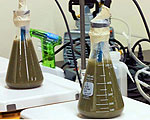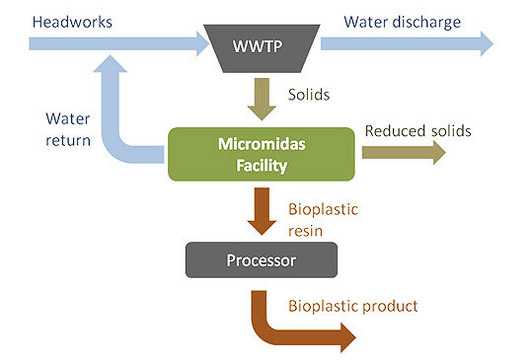Plastic From Sewage
 Mar-24-11
A new technology harnesses bacteria to create a bioplastic resin, creating plastic from sewage.
Mar-24-11
A new technology harnesses bacteria to create a bioplastic resin, creating plastic from sewage.The process, developed by Micromidas, transforms sewage into a biodegradable plastic by first removing the water and certain solids. A group of bacteria that address different parts of the sewage, such as sugars or fats, then work together to produce a bioplastic polystyrene that is similar to the top of a disposable coffee cup.
The bioplastic resin will biodegrade within 6 to 12 months.

More Info about this Invention:
[INHABITAT.COM][MICROMIDAS]
Add Comment
I'm confused by this. While I applaud what this group is doing, and I'm pleased that this is American innovation at work, the article claims that polystyrene is being produced. If bacteria are making polystyrene this is truly novel, but likely, I believe polyhydroxybutyrate is being produced. There are many bacteria found in municipal waste that produce this plastic. However, polyhydroxybutyrate, or PHB as it is known, is very brittle and not good for many applications. If the company is interested in marketing this technology, or the plastic resulting from this technology, then they should perhaps look into blending short and medium chain length polyhydroxyalkanoates, or find a natural isolate that creates mixed chain length copolymers or terpolymers.
Posted by Christopher Brigham on March 29, 2011
this is really an excellent idea for a country like pakistan ,where sewage waste is a serious environmental problem.wish you good luck for future
Posted by hadia fatima on April 2, 2011
Pepsi Cola just announced that they are converting their bottling materials to a PET plastic made from waste plant materials and will be switching to that in 2012.
http://www.seathos.org/pepsicos-green-bottle/
So this process should be of great interest to bottlers of all sorts.
Posted by Bud Taylor on April 4, 2011
On the face of it this looks like a great idea, I am however with Christopher brigham who points out that it is most likely polyhydroxy butyrate. If so this technology has been around for 30 years. Biogas is a much easier use of sewage, is more low tech, requiring less investment, uses larger qttys of sewage and can be universally applied in developed and under developed economies alike. In China they have 50,000,000 such installations on farms and businesses around the rural community where they provide heating, lighting and electricity. The gas generation part requries no moving parts or instrumentation and is thus well suited to any economy, and the remaining material is excellent fertiliser, so I suspect that the biogas option is better in the long run from an economic standpoint
Posted by Phil James on April 14, 2011
this is totally new idea in the past PHA and PHB was produced . i wish i will do something in this field. M.Phil (Microbiology) Quaid-i-Azam University Islamabab.
Posted by majis majeed on April 15, 2011
fields are required.
Comments
I'm confused by this. While I applaud what this group is doing, and I'm pleased that this is American innovation at work, the article claims that polystyrene is being produced. If bacteria are making polystyrene this is truly novel, but likely, I believe polyhydroxybutyrate is being produced. There are many bacteria found in municipal waste that produce this plastic. However, polyhydroxybutyrate, or PHB as it is known, is very brittle and not good for many applications. If the company is interested in marketing this technology, or the plastic resulting from this technology, then they should perhaps look into blending short and medium chain length polyhydroxyalkanoates, or find a natural isolate that creates mixed chain length copolymers or terpolymers.
Posted by Christopher Brigham on March 29, 2011
this is really an excellent idea for a country like pakistan ,where sewage waste is a serious environmental problem.wish you good luck for future
Posted by hadia fatima on April 2, 2011
Pepsi Cola just announced that they are converting their bottling materials to a PET plastic made from waste plant materials and will be switching to that in 2012.
http://www.seathos.org/pepsicos-green-bottle/
So this process should be of great interest to bottlers of all sorts.
Posted by Bud Taylor on April 4, 2011
On the face of it this looks like a great idea, I am however with Christopher brigham who points out that it is most likely polyhydroxy butyrate. If so this technology has been around for 30 years. Biogas is a much easier use of sewage, is more low tech, requiring less investment, uses larger qttys of sewage and can be universally applied in developed and under developed economies alike. In China they have 50,000,000 such installations on farms and businesses around the rural community where they provide heating, lighting and electricity. The gas generation part requries no moving parts or instrumentation and is thus well suited to any economy, and the remaining material is excellent fertiliser, so I suspect that the biogas option is better in the long run from an economic standpoint
Posted by Phil James on April 14, 2011
this is totally new idea in the past PHA and PHB was produced . i wish i will do something in this field. M.Phil (Microbiology) Quaid-i-Azam University Islamabab.
Posted by majis majeed on April 15, 2011
Add your Comment:
[LOGIN FIRST] if you're already a member.fields are required.

Show 5 Comments